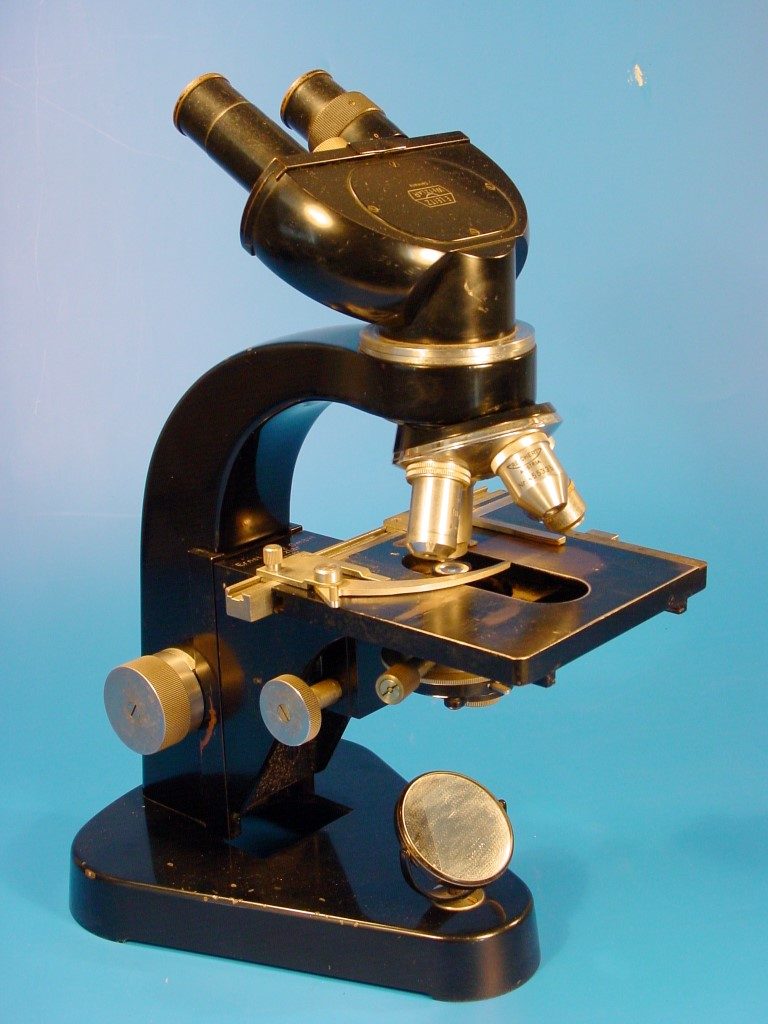
Year/Period |
1955-1957 |
Maker |
LEITZ |
Country |
Germany |
Signature |
Ernst Leitz / Wetzlar / 479051 |
Category |
Microscopes |
Optical 1 |
Compound |
Optical 2 |
Achromatic |
Size of the microscope (h x w x d) |
35.5 × 17 × 25 cm |
Inventory number |
SM 11 |
The SM stand is built around a triangular, cast and black enamelled aluminium plate on which a similar inverted L-shaped limb. Below the coarse and fine adjustment acting on the stage. The limb ends in a ring, below which various dovetailed nosepieces can be inserted. With this microscope goes a quadruple objective changer. On top of the ring of the limb is a bayonet mount for various types of eyepieces, with this microscope goes a binocular eyepiece. As there is no proper body tube a correction lens is inserted in the optical path correcting for a 170 mm body tube, as is usual for Leitz microscopes.
The large stage is provided with a simple mechanical stage. Below the stage the condenser.
There is only one set of eyepieces, ‘Leitz’ 6×B, the focal length is 42.08 mm and their magnification is 5.94×.
In the objective changer are four objectives, a plan objective by Reichert, which is a later addition and three original Leitz objectives.
The Reichert plan objective is specially corrected for a flat field (photography), it is signed: ‘Plan 4 / 0.10 160/ C. Reichert / Austria- no. 455335’.
The Leitz objectives are a ‘(3) 10:1 170/- A 0,25’, a ‘(6L) 45:1’ and a ‘100:1’.
The objectives were measured using the Bleeker microscope, for Reichert with a 160 mm body tube, the Leitz objectives with a 170 mm body tube. The Reichert objective and the Leitz 3 both with a 10×Huygenian eyepiece, the two stronger objectives with a 5× Huygenian eyepiece.
| Objective | 4 / 0.10 | 3 (10:1) | 6L (45:1) | 100:1 |
| Focal length (mm) | 28.85 | 16.26 | 3.98 | 1.90 |
| Magnification | 40.84 | 102.34 | 229.6 | 511.68 |
| Numerical aperture | 0.10 | 0.27 | 0.70 | 1.35 |
| Resolving power (µm) | 3.2 | 1.3 | < 0.8 | < 0.8 |
Reichert ‘4 / 0.10’ is spherically well corrected, there is some astigmatism present, the field is flat as might be expected from a plan objective.
Objective ‘3 (10:1)’ is well corrected, the diffraction rings are however a bit irregularly shaped.
Objective ‘6L (45:1)’ shows some spherical overcorrection. The Pleurosigma angulatum diatom is resolved into dots.
The front lens of objective ‘100:1’ is slightly damaged, as a result the diffraction rings of the star test are irregularly shaped. However, the objective still performs well, Pleurosigma angulatum and Surirella gemma are both resolved into dots.
Also see: SM 122